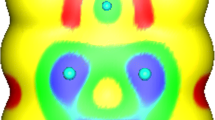Abstract
Based on the classical turning point of electron movement in a molecule, a model for defining the molecular characteristic boundary contour is advanced. By using an accurateab initio MELD program and an auxiliary program, some electron parameters in a molecule, such as the potential felt by an electron, have been evaluated. According to our model and definition, the molecular characteristic contour of the equilibrium geometry configuration is drawn and a vivid intuitive picture for describing the forming or breaking of a chemical bond is displayed.
Similar content being viewed by others
References
Mezey, P. G.,Shape in Chemistry, New York: VCH, 1993.
Grant, J. A., Pickup, B. T., A Gaussian description of molecular shape,J. Phys. Chem., 1995, 99: 3503.
Connolly, M. L., Solvent-accessible surfaces of proteins and nucleic acids,Science, 1983, 221: 709.
Eisenbery, D., Mclachlan, A. D., Solvation energy in protein folding and binding,Nature, 1986, 319: 199.
Abraham, M. H., Scales of solute hydrogen-bonding: their construction and application to physicochemical and biochemical processes,Chem. Soc. Rev., 1993, 22: 73.
Nicholls, A., Honig, B., A rapid finite difference algorithm, utilizing successive over-relaxation to solve the Poisson-Boltzmann equation,J. Comput. Chem., 1991, 12: 435.
Jahnson, M. A., Maggiora, G. M.,Concepts and Applications of Molecular Similarity, New York: Wiley, 1990.
Masek, B. B., Merchant, A., Matthew, J. B., Molecular shape comparison of angiotensin, II Receptor antagonists,J. Med. Chem., 1993, 36: 1230.
Lee, B., Richards, F. M., Interpretation of protein structures: estimation of static accessibility,J. Mol. Biol., 1971, 55: 379.
Connolly, M. L., Computation of molecular volume,J. Am. Chem. Soc., 1985, 107: 1118.
Yang, Z. Z., Davison, E. R., Evaluation of a characteristic atomic radius by anab initio method,International J. Quantum Chem., 1997, 62: 47.
Davidson, E. R.,MELD Program Description in MOTECC, New York: ESCOM, 1990.
Kohn, W., Sham, L. J., Self-consistent equations including exchange and correlation effects,Phys. Rev., 1965, 140: A1133.
Slater, J. C.,Quantum Theory of Atomic Structure, McGraw-Hill, New York, 1960, 2: 11–15. See also Slater J. C.,Phys. Rev., 1951, 81: 385.
Partridge, H. J., Near Hartree-Fock quality GTO basis sets for the second-row atoms,J. Chem. Phys., 1987, 87: 6643.
Author information
Authors and Affiliations
Additional information
Project supported by the National Natural Foundation of China (Grant No. 29873021).
Rights and permissions
About this article
Cite this article
Zhao, D., Yang, Z. Theory on the molecular characteristic contour (I). Sc. China Ser. B-Chem. 42, 391–399 (1999). https://doi.org/10.1007/BF02873968
Received:
Issue Date:
DOI: https://doi.org/10.1007/BF02873968




